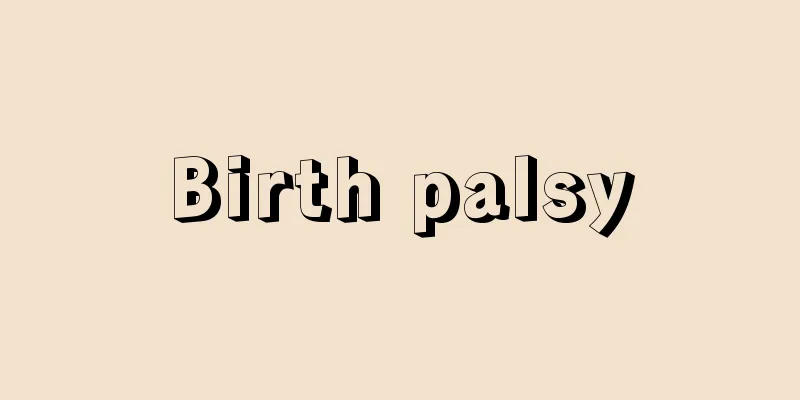Birth palsy

What is the disease?This is a disease in which newborns cannot move their upper limbs immediately after birth. There is no strength in the shoulders, and the entire upper limbs are limp without bending the elbows. In severe cases, the fingers cannot move at all, but in mild cases the fingers can move. The nerves that move the upper limbs travel from the cerebrum through the spinal cord to the peripheral nerves and then to the hands. On the way there, the nerves pass from the neck to the clavicle. What is the cause? During birth, the birth attendant pulled the baby too hard to remove it, causing excessive strain on the brachial plexus. Breech birth, There is no accurate data on the incidence of birth palsy in Japan, but the approximate incidence is thought to be 1 in 1,000 people. How symptoms manifestThe brachial plexus is a bundle of nerves that controls the movement and sensation of the upper limbs, and is composed of five thick nerves: the 5th, 6th, 7th, and 8th cervical nerves and the 1st thoracic nerve. The five nerves communicate in a complex manner, passing under the clavicle as a single unit, and finally branching out into individual peripheral nerves (Figure 1). The symptoms of birth palsy vary depending on which part of the brachial plexus has been damaged and to what extent. Paralysis is most severe at birth and usually improves after that. Approximately 9 out of 10 babies eventually recover completely, taking several days to several weeks, but some are left with severe paralysis. If the baby has not fully recovered by the time it is one month old, it is likely that it will have some kind of aftereffects, even if it continues to recover. Treatment methods The affected limb must be treated gently, but strict immobilization is not necessary. In severe cases where spontaneous recovery is not seen or is insufficient, surgery to repair the nerves is performed at 3 to 6 months of age. If paralysis persists, rehabilitation continues. In cases where functional recovery is poor, arthroplasty surgery or muscle-tendon transfer surgery may be performed around the time of school entry. Because joint contractures hinder functional recovery, if rehabilitation does not improve the condition, joint release surgery is performed promptly. What to do if you notice an illnessAsking the doctor involved in the birth about possible causes of paralysis will help with subsequent treatment. For the first 3-4 weeks after birth, observation at a general orthopedic clinic is sufficient, but if any paralysis remains at one month after birth, it is best to be referred to an orthopedic surgeon who specializes in hands (upper limbs). Hidehiko Kawabata "> Figure 1. Schematic diagram of the brachial plexus "> Table 1 Classification of birth palsy Birth palsy |
どんな病気か新生児が出生直後から上肢を動かさない病気です。肩にまったく力が入らず、肘を曲げずに上肢全体をだらっとさせています。重症例では手指もまったく動きませんが、軽症例では手指は動いています。 上肢を動かす神経は、大脳から脊髄を通って末梢神経となり、手に向かいます。その途中、神経は頸部から鎖骨のあたりで 原因は何か 出産時に赤ちゃんを取り出すために、分娩介助者が赤ちゃんを過度に引っ張った結果、腕神経叢に過大な 骨盤位分娩、 日本における分娩麻痺の発生頻度に関しての正確なデータはありませんが、およその発生頻度は1000人に1人と考えられています。 症状の現れ方腕神経叢は上肢の運動と知覚を司る神経の束で、第5・第6・第7・第8頸神経と第1胸神経の5本の太い神経から構成されています。5本の神経は複雑に交通し、ひとかたまりとなって鎖骨の下を通過して最終的に個々の末梢神経に分岐して終わります(図1)。 分娩麻痺の症状は、この腕神経叢のどの部分がどの程度損傷を受けたかで異なり、大きく分けて上位型 麻痺は出生時が最も重度で、その後回復していくのが普通です。およそ10人に9人は、数日から数週間かかって最終的に完全に回復しますが、重度の麻痺を残す場合もあります。生後1カ月の時点で完全に回復していなければ、その後回復が続いたとしても、何らかの後遺症を残すと考えなければなりません。 治療の方法 患肢を愛護的に扱う必要がありますが、厳密な固定は不要です。生後3~4週目からは関節 自然回復がみられないか、みられても不十分な重症例に対しては、生後3ないし6カ月の時点で神経修復手術を行います。その後も麻痺があればリハビリテーションを継続します。 機能回復不良例に対しては就学前ごろに関節形成手術や筋腱移行手術を行うこともあります。 関節拘縮は機能回復を妨げるため、リハビリテーションでよくならない場合は関節解離手術をすみやかに行います。 病気に気づいたらどうする出産に関与した医師に、麻痺の原因についてどのような可能性があるかを聞いておくと、その後の治療に役立ちます。生後3~4週間は一般整形外科での経過観察でよいですが、生後1カ月で何らかの麻痺が残っている場合は、整形外科のなかでも手(上肢)を専門にしている医師を紹介してもらったほうがよいでしょう。 川端 秀彦 "> 図1 腕神経叢模式図 "> 表1 分娩麻痺の分類 分娩麻痺
|
<<: Induction of labor - Induction of labor
>>: Fetal monitoring device - fetal monitoring device (English) tocomoniter
Recommend
Trichogaster trichopterus (English spelling)
…They do not breed until they are fully grown. (b...
Kyushu University Live Dissection Incident - Kyushu University Live Dissection Incident
…The experimental data was secretly taken back by...
Rathaus
… In addition, by accumulating various privileges...
VLDL - Virtual LDL
Very low- density lipoprotein, which is thought to...
Medici, A.de' (English spelling) MediciAde
...An Italian financial conglomerate that flouris...
School architecture
In the broadest sense, school architecture includ...
Tamas
…The material principle is composed of three elem...
parenchymal cell
The central vein is a small blood vessel that con...
Beyle, H.
…French novelist. His real name was Henri Beyle. ...
Hanging inkstone - Kakesuzuri
〘Noun〙① (Abbreviation of "kakesuzuribako (han...
Secure - Secure
〘 noun 〙① To obtain something, hold it tightly, an...
Peninsular and Oriental Steam Navigation
…the abbreviation for the British shipping compan...
character generator
…This character information memory is called refr...
Sixgill shark
...A marine fish of the family Sixgillidae in the...
Fan-zhen; Fan-chên
A local governing system with the Jiedushi as the ...









